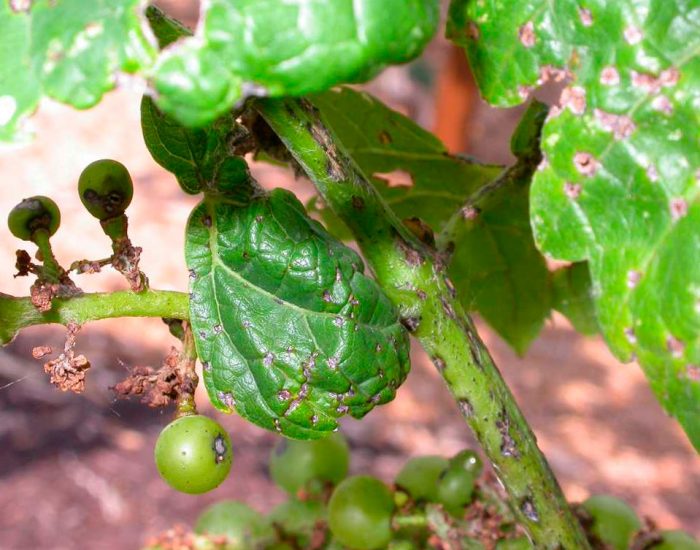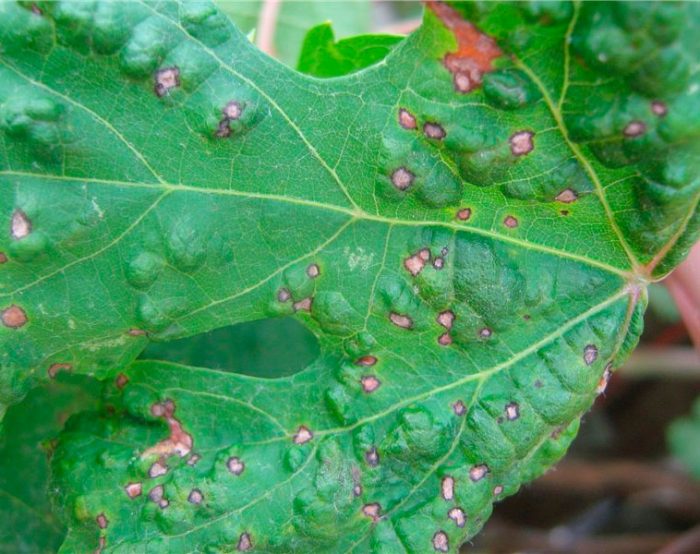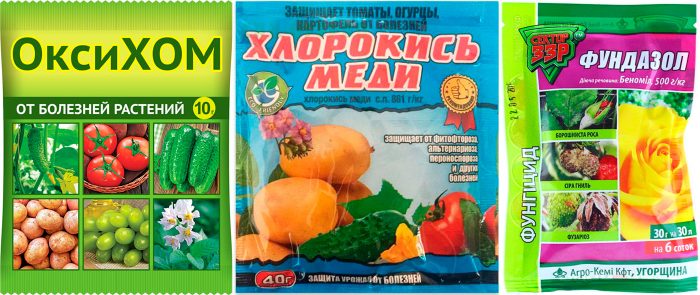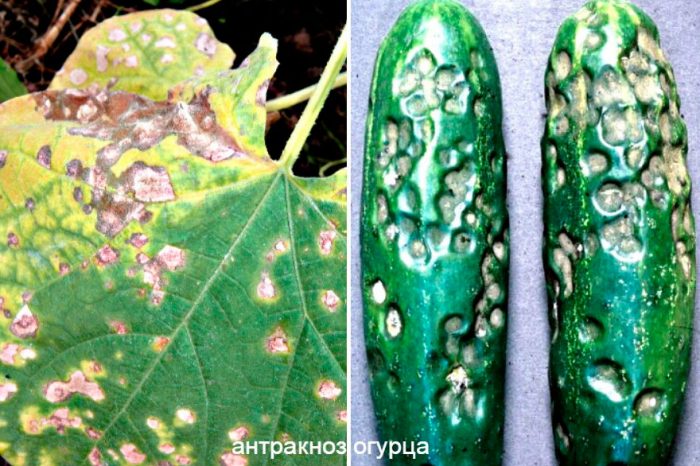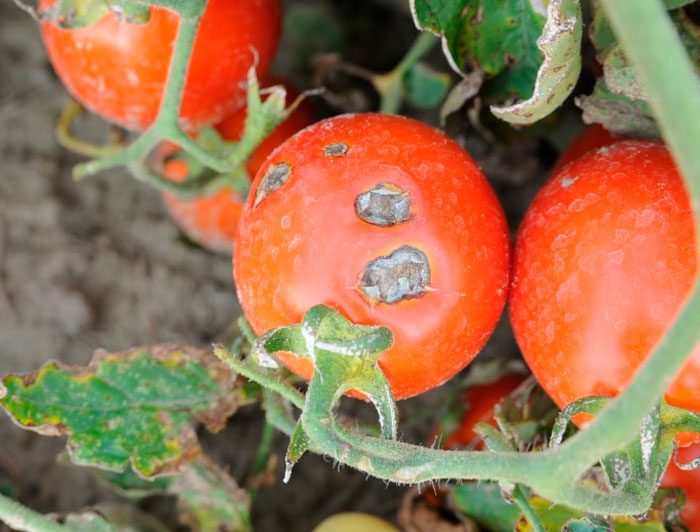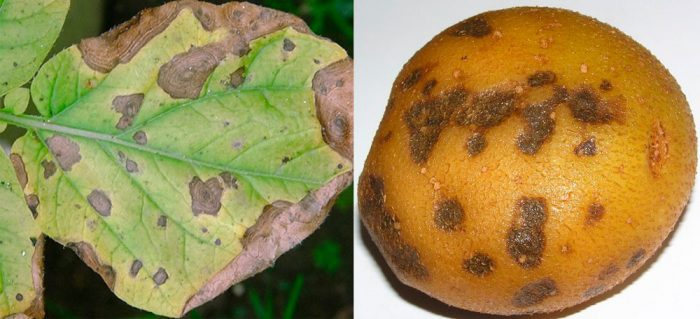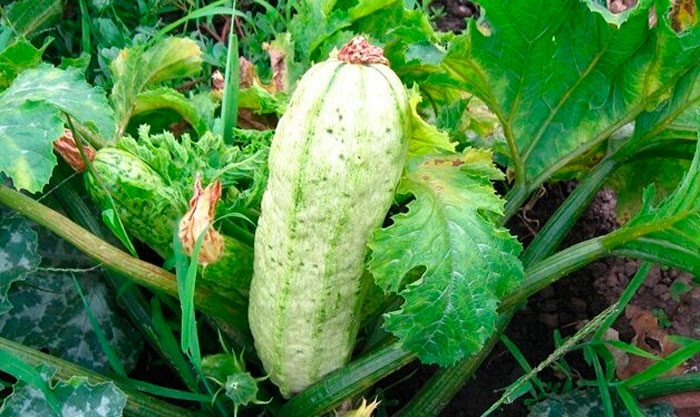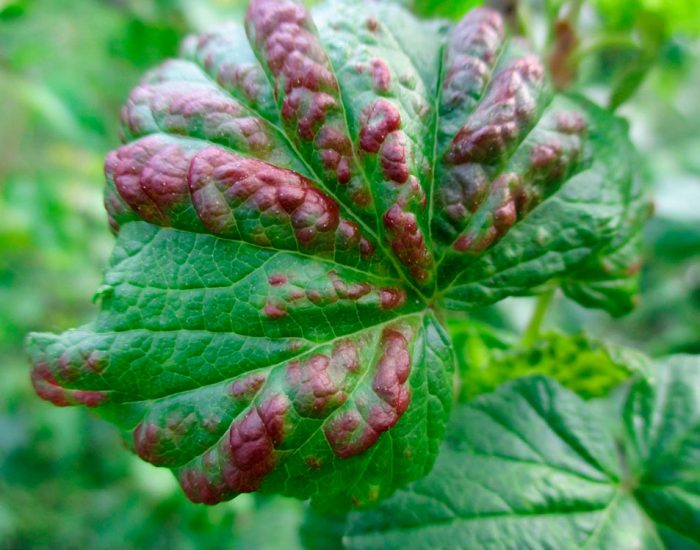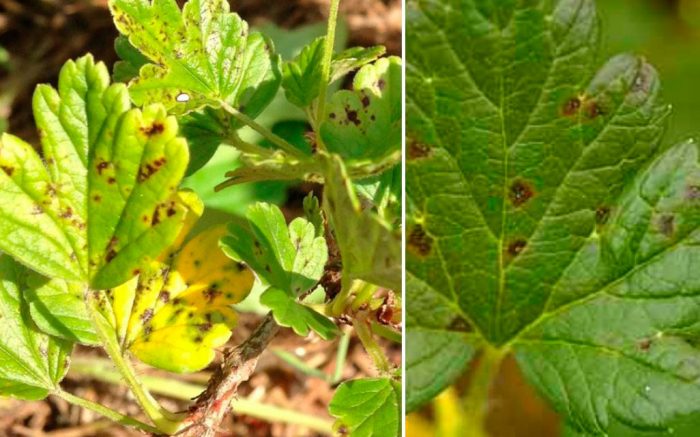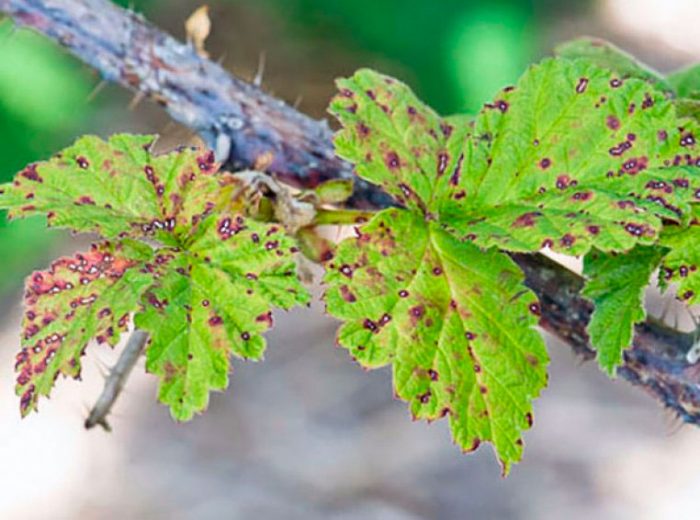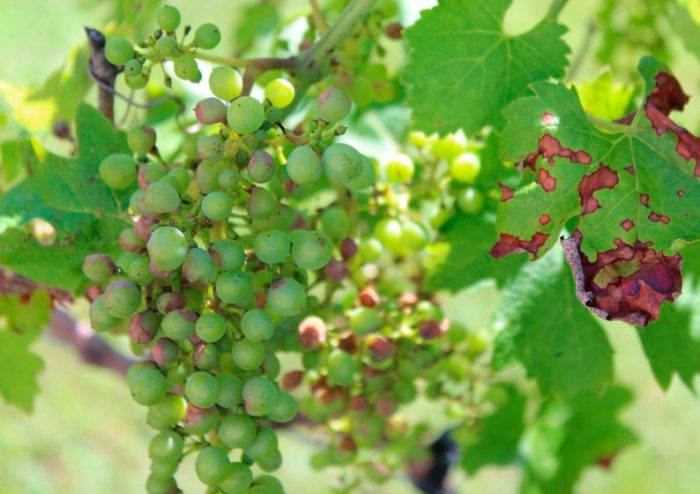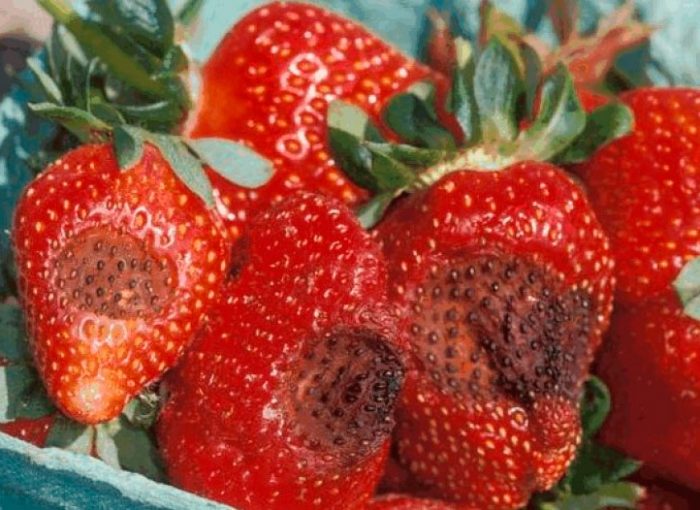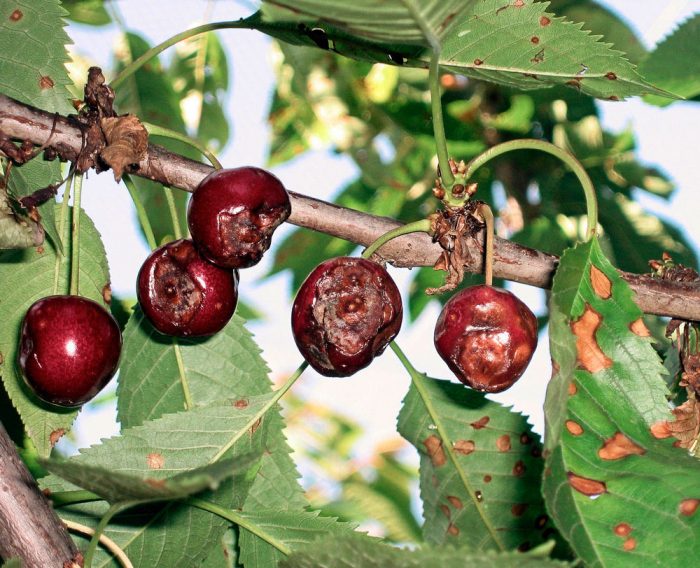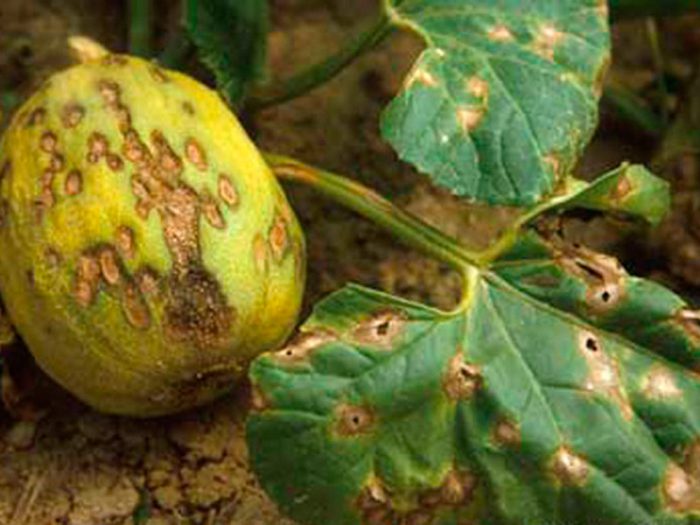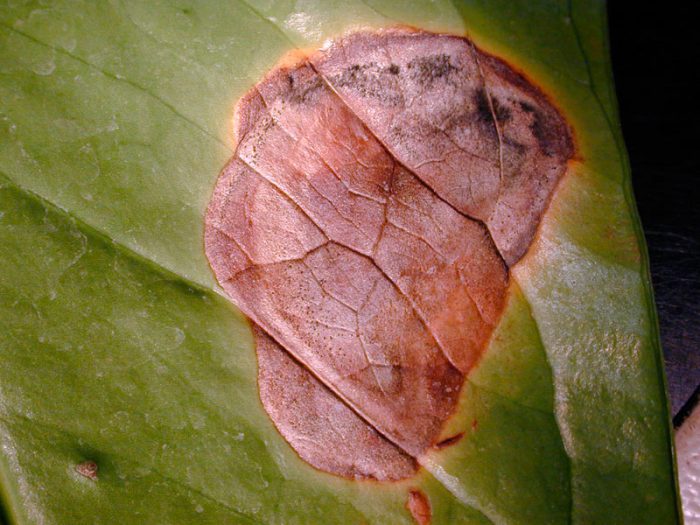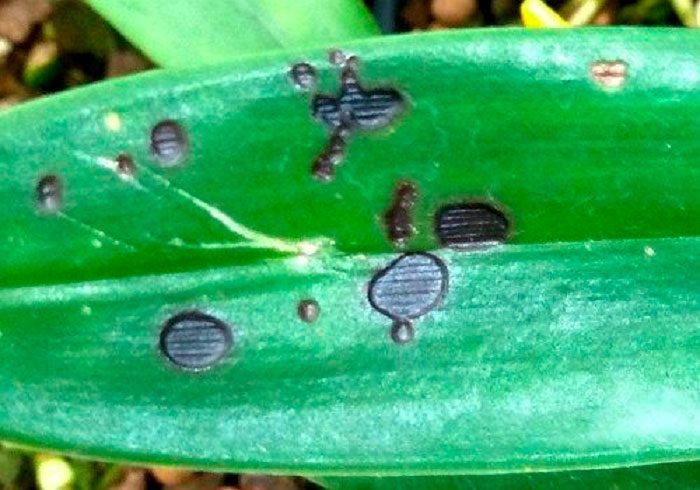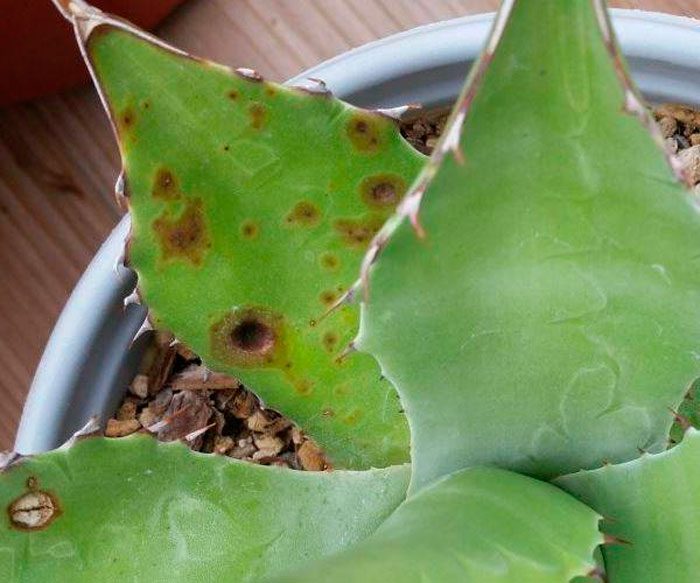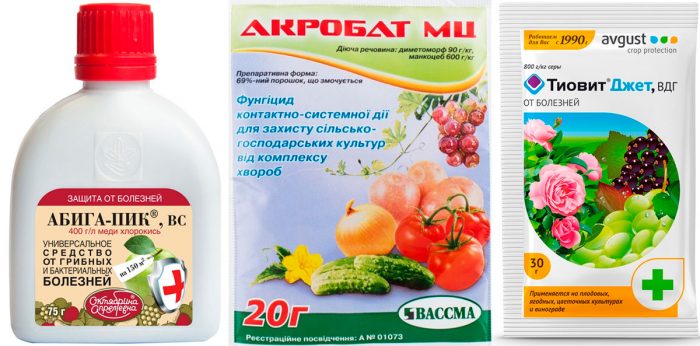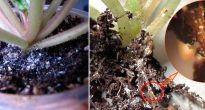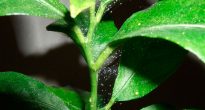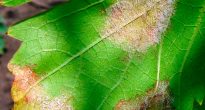Anthracnose (copperhead) disease is caused by imperfect deuteromycetes fungi: Kabatiella, Colletotrichum, Gloeosporium. The following plants are most susceptible to this disease: pumpkin, beans, zucchini, melons, almonds, watermelon, peas, grapes, cucumbers, citrus fruits and walnuts. Of the berry bushes, gooseberries, currants and raspberries most often get sick.
Content
Features of the disease anthracnose
Those plants that are weakened or have mechanical damage are most susceptible to damage by anthracnose. The spread of the disease occurs through infected seed material, as well as plant debris. Spores are carried from one place to another by insects, wind and raindrops. The most active development of the disease is observed at high humidity.
First of all, anthracnose affects the foliage, brown-red spots appear on its surface with a border of a darker shade or light yellow. Over time, the stains increase and they merge with each other. On the surface of branches and shoots, depressed areas form, they lead to difficulty in the movement of nutrients. These brownish specks of an oblong shape increase in size over time, and they also deepen, darken, and a rim of dark purple or brown appears around them. If the weather is dry, then many cracks appear on the surface of the affected areas. And with high humidity, rot forms in these areas, which leads to cracking of the stem or shoot at the site of the lesion. If the bush is not treated, then its foliage will turn brown and dry out, and this will also lead to the death of the entire aboveground part of the culture.
Anthracnose develops very quickly when the air humidity is high, for example, if it is cool outside (about 22 degrees) and the humidity level is 90 percent. And the development of the disease is facilitated by the low content of phosphorus and potassium in the soil, and its high acidity.
Anthracnose treatment
Since anthracnose is a fungal disease, fungicides are used to combat it.If clear signs of anthracnose damage have already been found on the bush, then to combat it, the most often used means are: Oxyhom, copper oxychloride, Previkur, Fundazol, Kuproksat, Acrobat MC, Ridomil Gold or Skor. These drugs very effectively cope with this disease, but to cure the plant, it will have to be treated twice or three times with a break of 1.5-3 weeks. In order to restrain the development of the disease, such microbiological agents as Fitosporin-M and Gamair are used.
But almost every gardener and gardener knows that it is much easier to prevent an anthracnose plant disease than to cure it later. That is why preventive measures to protect various crops from this disease should not be neglected.
Disease prevention
Pathogens of the disease can get into the garden or vegetable garden together with seeds, water for irrigation, garden tools, and various insects are also their carriers. With increased humidity, pathogens are activated, and the rapid development of the disease begins.
In order to prevent, strictly adhere to the rules of crop rotation, do not forget to disinfect the seeds before sowing, and in the autumn, clean the area of plant residues and dig the soil. Garden tools should always be clean, and cutting, dividing plants and inoculating should be done only with sterilized tools. In addition, at the very beginning of spring, before sap flow, as well as in autumn at the end of leaf fall, treat the bushes with Topsin-M solution, while it must be mixed with a growth stimulating agent, for example, with Epin, Zircon or with Immunocytophyte.
Anthracnose on garden crops
Cucumber anthracnose
In cucumbers, shoots, fruits and foliage suffer from anthracnose. At the same time, the symptoms of the development of the disease can be detected already in the seedling period: in the area of the root collar, the brown spots appear in the seedlings, over time they become ulcers, due to which young plants lie down. In adult bushes, the leaf plates are first damaged by the disease, spots of pale yellow or brown color 3–30 mm in size appear on their edges. In bushes growing in a greenhouse, leaf tissue from the center of the spots spills out and rounded holes appear. In open field cucumbers, these spots have a slit shape. After the leaf plates and shoots are affected by anthracnose, the disease passes to the fruits, oblong depressed areas of a pale pink or brownish hue are formed on them, they go 0.3–0.4 cm deep.
In order to cure the bushes that are affected by the disease in the root area, they are watered under the root with a solution of Abiga-Pique (0.5%) or Bordeaux mixture (1%), before that, moisten the soil well. If necessary, you can process cucumbers in this way 2 or 3 times in 7 days, but make sure that the solution does not get on the surface of the leaf plates. To spray the affected foliage, use a solution of Polyram or Copper Oxychloride, while you must follow the instructions. To get rid of anthracnose, you can also use agents such as Tiovit Jet, colloidal sulfur, or Cumulus. Also quite effective in the fight against anthracnose on cucumbers are such agents as: Stroby and Quadris.
Tomato anthracnose
Most often, already adult tomato bushes get sick with anthracnose. First, the upper leaf plates wilt, specks form on their surface, on which small black sclerotia are formed. On the surface of unripe fruits, depressed areas of dark color appear, which reach up to 10 mm in diameter. Over time, they become soft and black. As a result, fruit mummification occurs, as well as maceration of the root system, due to which the bush can be easily pulled out of the soil.The disease usually manifests itself in the last summer or early autumn weeks. If the defeat is massive, then you can lose more than half of the crop.
Breeders have bred hybrids that are highly resistant to anthracnose, for example, Long, Shelf or Life. However, even if you grow varieties that are not resistant to this disease, then timely preventive measures taken will help protect tomatoes from being affected by the disease:
- adhere to the rules of crop rotation;
- before sowing, process the seed in a solution of Immunocytafit or Agata-25;
- adhere to the agrotechnical rules of culture;
- timely carry out preventive treatment of tomatoes with a solution of Quadris or Strobi.
In the event that the plants were nevertheless affected by anthrocnosis, they can be cured with the help of such drugs as: Tiovit Jet, Poliram, Cumulus-DF, and also with Bordeaux mixture, colloidal sulfur or copper chloride (treatments are carried out in accordance with the instructions specified on the package).
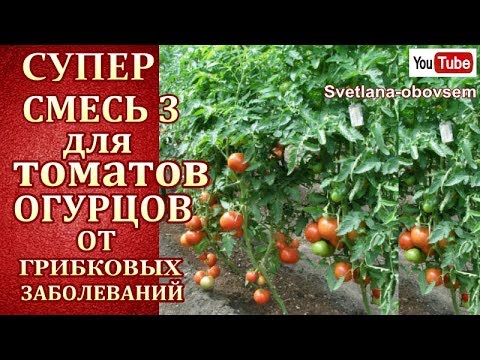

Watch this video on YouTube
Potato anthracnose
In potatoes, shoots and tubers are affected by anthracnose. Brownish specks form on the surface of the stems, after a while the shoots become angular and shortened, while chlorosis appears on the lower leaf plates. If the weather is dry, then the affected bushes begin to dry out, and with increased air humidity, the shoots are soaked, rotted and become slimy. On the surface of the tubers, vague specks of a dark brown hue are formed; during storage, the development of wet rot is observed in them.
In order to protect potatoes from being damaged by anthracnose, it is imperative to adhere to the rules of crop rotation; for this, such a vegetable is grown in the same area once every 3 or 4 years. For planting, you need to choose absolutely healthy tubers, which are treated with the fungicidal preparation Maxim before planting. Throughout the season, do not forget to promptly remove weeds from the site, especially the one that belongs to the Solanaceae family. When the crop is harvested, clean the surface of the soil in the garden from plant residues, while digging the soil deeply or it can be plowed. During storage of tubers, in order to contain the development of the disease, the air temperature in the storage should be about 1-3 degrees.
Zucchini anthracnose
All aerial parts of the squash bush can be affected by anthracnose. On the surface of the foliage, specks of a brownish-yellow color appear, and depressed areas are formed on the fruits and shoots, which are covered with a bloom of pink. The root part of the bush, which is affected by anthracnose, most often dies.
The disease, and in this case, begins to actively develop with high humidity and soil, and even when the bushes are watered in the heat. As soon as the first symptoms of the disease are found, spray the bushes with a solution of colloidal sulfur (5-6 grams per 1 liter of water); instead, you can use a Bordeaux mixture (1%). In order to prevent anthracnose, you need:
- adhere to the rules of crop rotation;
- carry out pre-sowing seed treatment;
- be sure to thoroughly examine the seedlings before planting in the garden;
- weeding on time;
- after harvesting, clean the area from plant residues;
- in the autumn, carry out a deep digging of the soil;
- systematically disinfect the greenhouse.
Anthracnose on shrubs and trees
Currant anthracnose
Currants are quite often affected by anthracnose. At the beginning, small brown spots are formed on the lower leaf plates, reaching about 1 mm in diameter. Over time, the spots grow in size and merge with each other. As the disease progresses, the foliage dries up and flies around. On the surface of the green stems and petioles, depressed spots appear, which eventually transform into wounds. On the fruits, single whitish ulcers are also formed.In the second half of the summer period, only a little young foliage remains on the affected bushes. It has been observed that red currants are more prone to anthracnose than black currants. The disease develops most actively during prolonged rains.
In order to save currants from anthracnose, you need to adhere to the following rules:
- In the autumn, the site is cleaned of loose leaves and plant debris left after pruning, which must be destroyed, since they are considered the main source of infection. Shrubs, as well as the surface of the soil around them, are sprayed with a solution of DNOC (1%) or Nitrafen (3%), after which the earth is dug up. Before the kidneys swell, repeat treatment with the same means.
- As soon as the bushes have bloomed, or after half a month after the first harvest of fruits, in order to prevent, spray the currants with a solution of Bordeaux mixture (1%) or a suspension of Tsineb, Kaptan, copper oxychloride, which is prepared exactly according to the instructions on the package. To cure anthracnose, you can use the following fungicidal agents: Cumulus-DF, Tiovit Jet or colloidal sulfur.
- Experts advise changing the usual currants to varieties that are resistant to anthracnose, namely: red currant - Bessemyanka, London Market, Chulkovskaya, Holland red; black currant - Dove, Velvet, Kryzhovichnaya, Stakhanovka, Altai and Katun.
Gooseberry anthracnose
Since currants and gooseberries are closely related, the manifestation of anthracnose on these shrubs is no different. Therefore, it is necessary to fight this disease on the gooseberry using the same methods and means as with the defeat of currants.
Raspberry anthracnose
In the affected raspberry bushes, small roundish specks of brownish-gray color with dark red edging are formed on the foliage. Over time, the spots become larger and gradually merge with each other. Deep, but small ulcers form on the surface of the affected stems. Affected flower shoots, stem tops and flowers dry up, and fruit mummification is observed.
In order to avoid damage to raspberries by anthracnose, experts advise purchasing those seedlings that are resistant to this disease. When planting bushes, be sure to observe the distance between them, which is recommended by experts. Remember, low-lying areas are not suitable for growing such a shrub, and it also needs the correct watering regime.
To cure raspberries affected by anthracnose, it is necessary to cut out all diseased branches as soon as possible, and treat the bushes themselves with a solution of a fungicidal preparation. However, it is much easier to prevent the development of the disease, for this, carry out preventive treatments in a timely manner: the first spraying - at the beginning of the spring period before the buds open, the second - one and a half weeks after the first treatment, the third - immediately after harvesting the fruits, the fourth - in the autumn time, when it ends leaf fall. For treatment, you can use a fungicidal agent such as a solution of copper chloroxide (for 1 liter of water 5 grams) or Bordeaux mixture (1%).
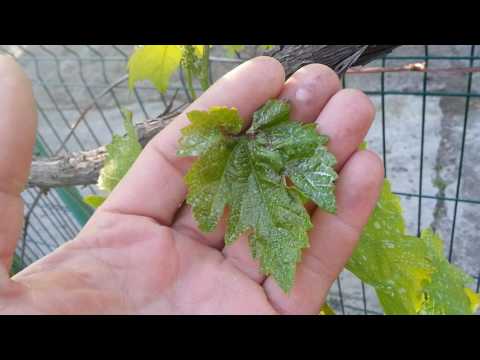

Watch this video on YouTube
Grape anthracnose
Grapes are less susceptible to anthracnose attack than the crops described, but they can be very much affected by this disease. Varieties that are resistant to mildew and powdery mildew are most susceptible to this disease, since they are not sprayed with fungicidal preparations. The most resistant to this disease are such grape varieties as: Sauvignon, Rkatsiteli, Traminer and Riesling.
The development of the disease is observed in all green parts of the bush, since only young tissues are affected by anthracnose. The foliage is affected by the disease only before the age of 25 days, the stems - until they become lignified, and the fruits - before they begin to ripen. On the affected foliage, pale gray spots with light red or dark edging are formed. Over time, the spots become larger and the fabric inside the rims loosens.Brown spots appear on the stems, which after a while become deep coffee-colored sores with a dark purple border. If the grapes are very badly affected, their stems turn black, as if charred, and they become very fragile. The foliage on them becomes smaller and becomes chlorotic. Sores also appear on the inflorescences, then their drying is observed, as well as partial or complete dying off.
The affected bushes are sprayed with a solution of Bordeaux mixture (1%). The first time the plants should be treated with a fungicidal preparation should be in the spring after the length of young shoots is 10 centimeters. The following remedies very effectively fight such a fungal disease: Previkur, Ordan, Acrobat, Abiga-Peak, Fundazol, Skor, MC and also copper sulfate. Plants are sprayed systematically with a break of 15 days. If it rains after the treatment, then it must be repeated. Experts advise to alternate means, otherwise resistance may develop (addiction to the drug). Cut and burn any diseased areas before spraying.
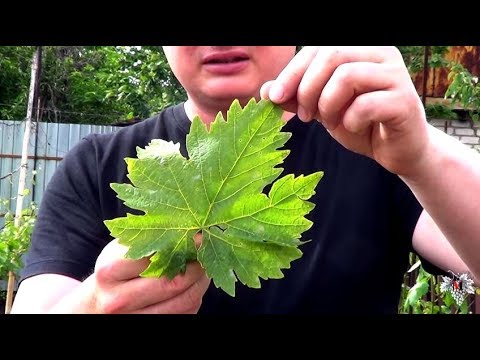

Watch this video on YouTube
Strawberry anthracnose (wild strawberry)
When strawberries are affected by garden anthracnose, the gardener can lose up to 80 percent of the fruits. In this case, the disease is dangerous in that it destroys the plant, but for a long time the symptoms of anthracnose may not appear at all. Anthracnose affects all aerial parts of the bush. On the upper part of the leaf plates and on the whiskers, depressed small specks of brownish-red color are formed, which eventually become sores. Over time, they increase in size and merge with each other, covering large areas, due to which the foliage dies off. From the mustache and foliage, the disease spreads to fruits and flowers. Externally, the affected flowers look as if they were burnt, and they die off. The infection enters the ovary through the stamens on the flowers, which is why on the fruits depressed spots of a dark shade are formed, which reach 15-30 mm in diameter, over time they dry out and turn brownish-brown. At high humidity in the affected areas, a mucous crust of pale pink or yellow appears on the berries, and if the weather is dry, then mummification of diseased fruits occurs.
In order to prevent strawberries from being damaged by anthracnose, for planting you need to take absolutely healthy seedlings, while before planting they are immersed in a fungicidal solution for half an hour. Then, during flowering and during the formation of ovaries, the bushes are treated 3 or 4 times with a solution of a fungicidal agent. The Italian remedy Signum is very effective against anthracnose. And experts also advise, for cultivation, choose varieties that are highly resistant to anthracnose, for example: Daver, Charlie's Light, Pelican, Pegan or Idea.
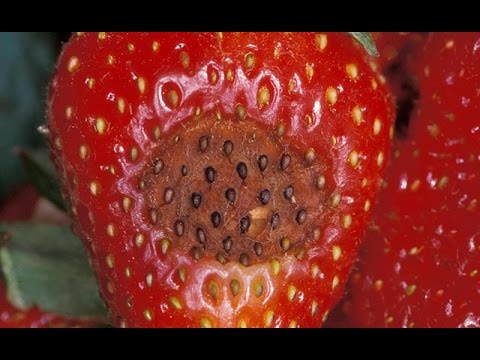

Watch this video on YouTube
Cherry anthracnose
Anthracnose can also affect garden stone fruit trees, such as cherries. By the middle of the summer period, hard dry spots form on the fruits of the affected plant, they gradually increase and then completely cover the entire berry. Due to this disease, the gardener can lose up to half of the harvest, in this regard, it is very important to pay special attention to preventive measures. In early spring, prune your cherries sanitized. If the crown is properly thinned, it will be better ventilated and dry faster after rain, while pathogenic fungi will die in the sun. After the cherry is cut off, spray the plant with a solution of Bordeaux mixture (1%) while the buds have not yet woken up, and after 7 days, treat with milk of lime (for 1 bucket of water 2 kilograms). Wood ash must be added to the soil of the trunk circle, and after a while, sprinkle its surface with a layer of mulch (manure).Throughout the growing season, at least 3 additional fertilizing must be carried out, namely: at the beginning of the spring period with nitrogen-containing fertilizers to stimulate the growth of stems, and when the plant has faded, as well as in the last summer or first autumn weeks - with phosphorus-potassium fertilizers. After the crop is harvested, spray the cherries with a solution of copper sulfate (10 grams per 1 liter of water). When the leaf fall ends, remove the loose leaves, treat the plant and the trunk circle with a solution of urea (50 grams per 1 liter of water).
Watermelon and melon anthracnose
Anthracnose can also affect pumpkin crops such as watermelons and melons. This disease affects all aboveground parts of pumpkin, however, shoots suffer the most in crops, they become very fragile. In the affected fruits, development stops, their deformation occurs and their taste is lost, since the amount of sugar in them decreases. On the surface of the fruit, depressed rotten specks appear, which are covered with pale pink spore pads. The pads eventually connect with each other, as a result of which the fruit is completely covered with a coating of a copper hue, because of this, anthracnose is also called copperhead.
For preventive purposes, after the crop is harvested, remove and destroy the tops, because there may be pathogenic fungi on it, and then be sure to deep plow the area. Remember the rules of crop rotation, you can grow pumpkin crops on the same plot no more than 1 time in 5-7 years. Alfalfa is considered the best predecessor of watermelons and melons.
Before sowing, be sure to process the seed, in this case the risk of anthracnose damage is minimal. However, if the melons and gourds are still affected by this disease, then they must be treated 3 times with Kuproksat solution. So, the first spraying is carried out during the formation of lashes, the second - during the formation of ovaries, and the third - half a month after the second treatment. But remember that you can spray the bushes for the last time no later than 20 days before harvest.
Anthracnose on flowers
Anthracnose anthurium
Anthracnose can affect even an indoor flower. The development of the disease on anthurium is facilitated by high humidity and heat (more than 20 degrees). On the edge of the leaf plates, small specks of brown color are formed, which over time increase and connect to each other, until the dying off of the leaf tissue reaches the midrib. As a result, the affected tissues fall out.
At the first signs of illness, you need to take all the necessary measures to cure the plant, namely:
- remove the affected flower away from other plants;
- reduce the number and volume of watering to a minimum;
- cut off all affected leaves;
- replace the soil mixture in the container with a sterile one;
- be sure to disinfect the pot.
During transplantation, immerse the root system of the flower for 10 minutes in a weak solution of potassium manganese. When the flower is transplanted, it is sprayed with some fungicidal preparation, for example: Previkur, Abiga-Peak or Acrobat MC. If the bush is very badly affected, then it is best to use Fundazol, Skor, Ridomil Gold MC or other means of similar action for processing.
Anthracnose on an orchid
Affected leaf plates differ from healthy ones in that spots with very clear edges form on them, this is similar to the fact that a red-hot coin was pressed into the leaf. On the foliage of phalaenopsis, the color of the spots is black, while on other types of orchids, their color may be different, even white. A loose formation appears at the base of the leaf blades of the affected flowers. Try to save at least part of the affected leaf plate, if possible, while the places of the cuts must be treated with brilliant green, chopped charcoal or cinnamon powder. If possible, change the substrate to a new one, and be sure to treat the container with a strong solution of manganese potassium. It is best to use the latest generation products for processing orchids: Trichodermin, Fitosporin-M or Baktofit.Also, the affected plant can be sprayed with organic agents, for example, Maneb, Mankozeb or another preparation of a similar effect.
Anthracnose on cacti
Cacti are very rarely affected by anthracnose when they are kept at very high humidity, which is contraindicated for succulent crops. On plants, depressed spots form, while they sometimes have a bright border. The disease spreads very quickly through the pulp of the cactus, in this regard, you should not hesitate. All affected areas must be carefully cut out with a pre-sterilized instrument, while capturing some healthy tissue. Next, process the cut points with carbon powder. For the treatment of cacti, fungicidal preparations are not used, since they can destroy this plant. In this case, it is recommended to lower the humidity level to a minimum, and then the development of the fungus will stop. At the same time, the plant itself will not suffer from excessively dry air.
Anthracnose preparations
To cure a plant that is affected by anthracnose, you must treat it with a fungicide. Below will be described those drugs that are used by gardeners and gardeners most often:
- Abiga Peak... It is a broad spectrum contact agent that contains copper. It is moderately hazardous. If you strictly follow the instructions, then the substance is not phytotoxic.
- Acrobat MC... The agent has a systemic-local effect, it is used in the treatment of most fungal diseases, and is toxic.
- Bordeaux mixture... Such a broad-spectrum contact preparation is used to treat melons, vegetables, berries, flowers and fruit crops to protect against a variety of diseases.
- Previkur... This systemic agent is not only protective, it also stimulates growth. It is used in the fight against a large number of diseases. The substance has a moderate hazard; if it comes into contact with the mucous membrane of the eyes or skin, they are very slightly irritated.
- Ridomil gold... Such a systemic contact agent is used to protect plants from a variety of diseases.
- Speed... A systemic drug that is used both for the treatment and for the prevention of a large number of fungal diseases, for example, powdery mildew, curly leaves, scab, late blight, Alternaria and other diseases. Differs in moderate danger.
- Tiovit Jet... It is both a fungicidal and an acaricidal agent used to protect vegetable, fruit and flower crops, as well as grapes from various fungal diseases. The hazard of this substance is moderate.
- Topsin-M... A systemic drug used for the treatment and prevention of diseases, which is also effective in treating the soil surface. Does not cause irritation in contact with skin and mucous membranes.
- Trichodermin... A biological product used for both treatment and prevention of diseases, it heals the earth. It is absolutely not dangerous for bees, birds, fish and humans, it is not phytotoxic, and its accumulation in soil and plants is not observed.
- Fitosporin-M... Contact biological agent. This microbiological preparation protects garden, garden, indoor and greenhouse crops from bacterial and fungal diseases. It has a low toxicity to humans, but it can harm bees and plants.
- Fundazol... Systemic broad-spectrum drug, also used as a seed dressing agent. It is used for both treatment and prevention of diseases, however, after the plant has been treated 2 or 3 times, the pathogens develop resistance.
- Strobe... A local-systemic agent of a wide spectrum of action, it is used in the fight against fungal diseases.Differs in resistance to precipitation.
- Quadris... A broad-spectrum drug used to combat various fungal diseases, which has a therapeutic, prophylactic and eradicating effect.
- Cuproxat... Contact fungicide, herbicide is used to prevent fungal diseases. Among the most effective remedies that contain copper.
- Oxyhom... Systemic contact agent with a wide spectrum of action, it is used for various fungal diseases. The product is very toxic.
- Ordan... Contact-systemic drug used for various fungal diseases, for example: late blight, alternaria, anthracnose, etc. It is characterized by moderate danger.
Folk remedies
Any folk remedies are not very effective in the fight against anthracnose, so they are not recommended to use.
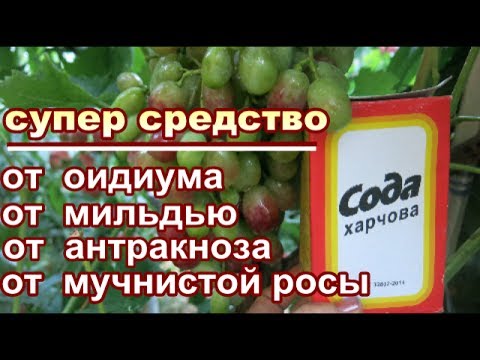

Watch this video on YouTube

